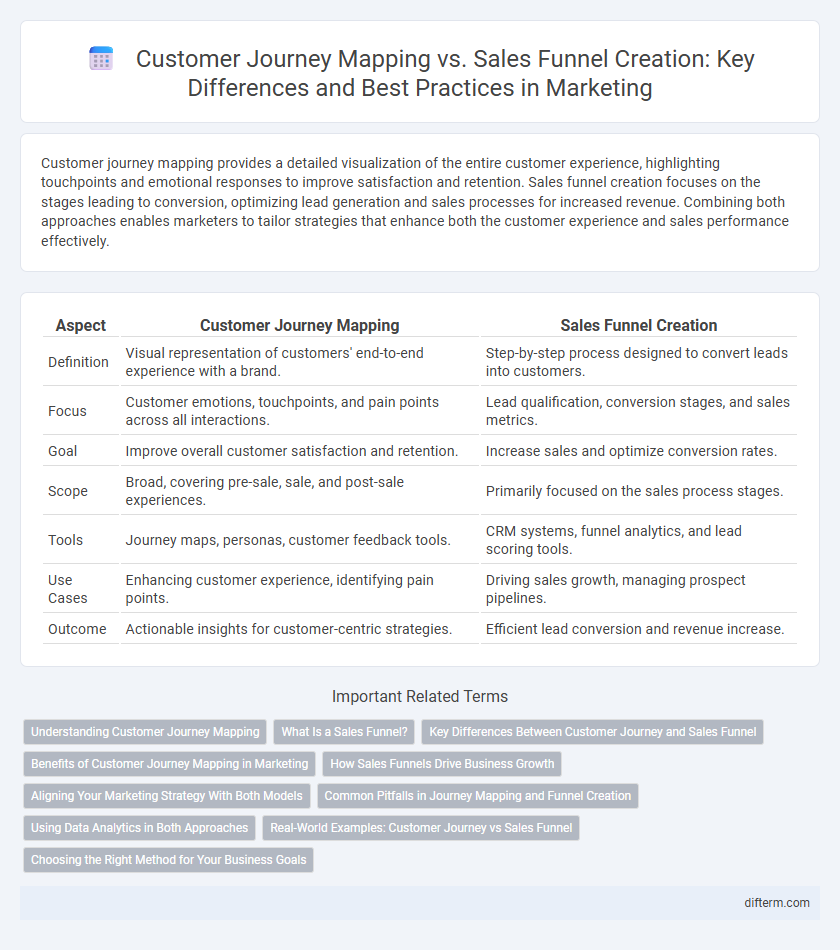Customer journey mapping provides a detailed visualization of the entire customer experience, highlighting touchpoints and emotional responses to improve satisfaction and retention. Sales funnel creation focuses on the stages leading to conversion, optimizing lead generation and sales processes for increased revenue. Combining both approaches enables marketers to tailor strategies that enhance both the customer experience and sales performance effectively.
Table of Comparison
| Aspect | Customer Journey Mapping | Sales Funnel Creation |
|---|---|---|
| Definition | Visual representation of customers' end-to-end experience with a brand. | Step-by-step process designed to convert leads into customers. |
| Focus | Customer emotions, touchpoints, and pain points across all interactions. | Lead qualification, conversion stages, and sales metrics. |
| Goal | Improve overall customer satisfaction and retention. | Increase sales and optimize conversion rates. |
| Scope | Broad, covering pre-sale, sale, and post-sale experiences. | Primarily focused on the sales process stages. |
| Tools | Journey maps, personas, customer feedback tools. | CRM systems, funnel analytics, and lead scoring tools. |
| Use Cases | Enhancing customer experience, identifying pain points. | Driving sales growth, managing prospect pipelines. |
| Outcome | Actionable insights for customer-centric strategies. | Efficient lead conversion and revenue increase. |
Understanding Customer Journey Mapping
Customer Journey Mapping provides a detailed visualization of every interaction customers have with a brand, highlighting their emotions, needs, and pain points at each stage. This approach enables marketers to create personalized experiences by understanding the customer's perspective beyond simple sales metrics. By uncovering critical touchpoints and decision triggers, businesses can optimize marketing strategies and improve overall customer satisfaction and retention.
What Is a Sales Funnel?
A sales funnel is a strategic model that visualizes the stages a potential customer goes through from awareness to purchase, enabling marketers to optimize conversion rates effectively. It outlines key phases such as lead generation, qualification, decision-making, and closing, allowing targeted marketing efforts tailored to each step. Understanding the sales funnel helps businesses streamline their sales process and improve customer acquisition efficiency.
Key Differences Between Customer Journey and Sales Funnel
Customer Journey Mapping tracks the entire customer experience from awareness to loyalty, highlighting emotional touchpoints and user behavior across multiple channels, while Sales Funnel Creation focuses primarily on the stages of converting leads into customers through a linear process of awareness, consideration, and decision. Customer Journey Mapping provides a holistic view of customer interactions and satisfaction metrics, whereas Sales Funnel emphasizes lead nurturing, conversion rates, and sales performance metrics. Understanding these distinctions enables marketers to tailor strategies for engagement versus direct conversion optimization.
Benefits of Customer Journey Mapping in Marketing
Customer journey mapping provides a detailed visualization of each customer interaction, enabling marketers to identify pain points and optimize touchpoints for enhanced customer experiences. Unlike sales funnels that focus primarily on conversion stages, journey mapping captures emotional and behavioral insights, improving personalized marketing strategies and fostering long-term customer loyalty. This holistic approach drives higher engagement rates, better resource allocation, and increased return on investment (ROI) in marketing campaigns.
How Sales Funnels Drive Business Growth
Sales funnels drive business growth by systematically guiding potential customers through stages of awareness, interest, decision, and action, optimizing conversions at each touchpoint. Unlike customer journey mapping, which provides a broad overview of customer experiences, sales funnel creation focuses on measurable outcomes and targeted strategies to increase lead generation and sales efficiency. Data-driven funnel optimization enhances marketing ROI by identifying bottlenecks and tailoring messaging to specific audience segments, accelerating revenue growth.
Aligning Your Marketing Strategy With Both Models
Aligning your marketing strategy with both customer journey mapping and sales funnel creation enhances targeting precision and engagement effectiveness. Customer journey mapping provides deep insights into touchpoints and emotional experiences, while sales funnel creation focuses on conversion optimization through defined stages. Integrating these models ensures a cohesive approach that drives personalized messaging and maximizes conversion rates across all channels.
Common Pitfalls in Journey Mapping and Funnel Creation
Customer journey mapping and sales funnel creation often suffer from common pitfalls such as unclear customer personas and incomplete data integration, leading to ineffective targeting. Overlooking touchpoint inconsistencies and failing to align marketing channels can disrupt the accuracy of both models. Neglecting ongoing analysis and adaptation hampers the ability to optimize customer conversion and retention strategies.
Using Data Analytics in Both Approaches
Customer Journey Mapping and Sales Funnel Creation both leverage data analytics to enhance marketing strategies by identifying customer behaviors and key touchpoints. In Customer Journey Mapping, data analytics reveals detailed emotional and behavioral patterns throughout every stage of interaction, enabling personalized experience optimization. Sales Funnel Creation uses analytics to track conversion rates and identify drop-off points, focusing on improving lead progression and boosting sales efficiency.
Real-World Examples: Customer Journey vs Sales Funnel
Customer journey mapping visualizes the entire customer experience by highlighting touchpoints and emotions across multiple channels, such as Nike's personalized app interactions and in-store experiences. Sales funnel creation narrows focus on converting leads into customers through defined stages, exemplified by Shopify's targeted email campaigns and checkout optimizations driving purchase decisions. Real-world applications demonstrate that customer journey mapping enhances brand loyalty, while sales funnel creation maximizes immediate sales conversion.
Choosing the Right Method for Your Business Goals
Customer Journey Mapping provides a detailed visualization of customer interactions across touchpoints, helping businesses enhance user experience and identify pain points. Sales Funnel Creation focuses on driving prospects through stages of awareness, interest, and conversion, optimizing lead generation and sales processes. Selecting the right method depends on whether the primary goal is improving overall customer engagement or increasing direct sales efficiency.
Customer Journey Mapping vs Sales Funnel Creation Infographic

 difterm.com
difterm.com